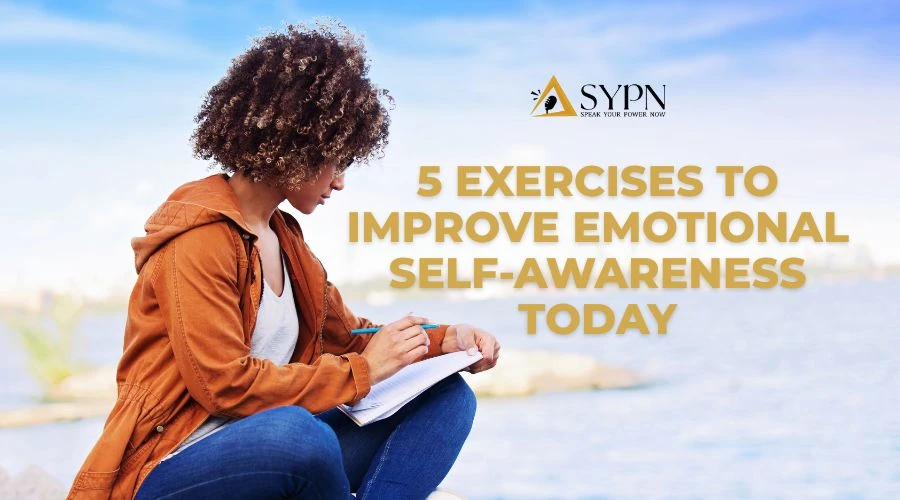Introduction
Self-awareness is the cornerstone of emotional intelligence. It’s your ability to understand your thoughts, emotions, and triggers in real time—without judgment. When you know what you’re feeling and why, you gain the power to respond instead of react. The good news? Emotional self-awareness isn’t something you’re born with or without—it’s a skill you can build with consistent, intentional practice. In this post, we’ll walk through five practical exercises you can start doing today to strengthen your emotional self-awareness.
Why Emotional Self-Awareness Matters
“You can’t manage what you don’t notice.” That’s the heart of it. If you’re unaware of your emotional state, you’re at the mercy of it. Emotional self-awareness gives you the ability to:
- Pause and reflect instead of reacting impulsively.
- Identify the root causes of stress, anger, sadness, or anxiety.
- Communicate more clearly and empathetically with others.
- Make decisions that are more aligned with your values.
Developing emotional self-awareness isn’t about becoming overly analytical or overthinking everything you feel. It’s about learning to check in with yourself in a way that builds clarity, confidence, and emotional resilience.

Exercise #1: Mood Journaling
What it is: A daily practice of writing down your emotional experiences.
How to do it:Set aside 5–10 minutes at the end of each day.Answer these questions in a journal:
- What emotions did I feel today?
- What triggered those emotions?
- How did I respond?
- How do I feel about how I responded?
Why it works: Writing helps externalize your emotions so you can observe them more objectively. Over time, you’ll start noticing patterns—certain people, places, or situations that consistently impact how you feel. Mood journaling also gives you a safe space to process complex feelings.
Pro tip: If words feel hard, use colors or emojis to reflect your mood.

Exercise #2: Emotion Check-Ins
What it is: A quick self-inquiry done multiple times a day.
How to do it:Set a timer on your phone for three times a day (morning, midday, evening).When the timer goes off, pause and ask:
- What am I feeling right now?
- Where do I feel it in my body?
- What do I need?
Why it works: This practice keeps you connected to your inner world instead of running on autopilot. Checking in helps you shift from being swept up in emotion to consciously engaging with it.
Pro tip: Create a recurring calendar event or habit tracker to build consistency.

Exercise #3: Name it to Tame it
What it is: A mindfulness technique that involves identifying your emotions precisely.
How to do it:The next time you feel overwhelmed, pause. Label the emotion as clearly as possible:
- Instead of saying “bad,” try “disappointed,” “guilty,” “lonely,” or “overstimulated.”
- Say it out loud or write it down.
Why it works: When you name an emotion, you engage the rational part of your brain, which helps calm the emotional center. Neuroscientific studies show that labeling emotions reduces their intensity.
Pro tip: Use an emotion wheel or chart to help you expand your emotional vocabulary.

Exercise #4: Body Scan
What it is: A practice to tune into physical sensations as emotional cues.
How to do it:Sit or lie down in a quiet space. Take a few deep breaths and gently scan your body from head to toe. Notice any areas of tightness, tension, or discomfort.
- Ask: What emotion might this sensation be connected to?
Why it works: Your body often knows what you’re feeling before your mind catches up. A clenched jaw might point to anger. A tight chest could signal anxiety. The body scan teaches you to listen to these subtle signals.
Pro tip: Pair your body scan with gentle stretching or breathing exercises.

Exercise #5: Reflective Questioning
What it is: Asking yourself questions that dig deeper into emotional experiences.
How to do it:After a significant emotional event (positive or negative), take 5–10 minutes to reflect on:
- What exactly triggered this feeling?
- What did I need in that moment?
- What belief or story did this feeling activate?
- What could I do differently next time?
Why it works: Reflective questioning builds insight. It helps you uncover the “why” behind your emotions and identify unmet needs, boundary violations, or internalized narratives that affect your well-being.
Pro tip: Don’t judge your answers. Stay curious, not critical.
Bonus Tip: Make It Playful
Not every emotional check-in has to be deep and serious. If you’re more visual or creative, try using mood colors, stickers, or emojis in your journal. You can even create a simple key (e.g., blue = sad, red = angry, yellow = hopeful) to track patterns over time.
Or use an app like Daylio or Moodnotes that makes the process fun and interactive.
The goal is consistency—not perfection. The more you check in with yourself, the more natural it becomes.
Final Thoughts
Emotional self-awareness isn’t about being in control all the time. It’s about creating enough space between what you feel and what you do so that your actions are intentional, not impulsive. These five exercises can help you slow down, tune in, and respond to life with more clarity and compassion.
Start with one. Then build. Emotional awareness is a lifelong journey, and every small practice adds up.
Want to make this a daily habit? Download our Daily Emotional Check-In Template—a printable guide to help you track your emotions, identify triggers, and grow your self-awareness one day at a time.
You’ve got this. Your feelings are valid—and worth listening to.



